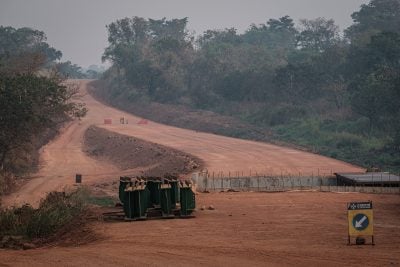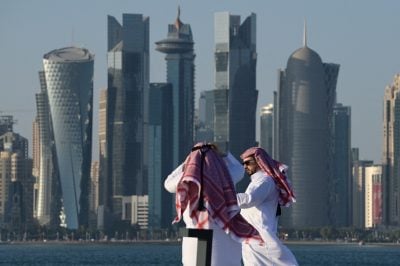Inside a health clinic in the north Ethiopian region of Tigray, a nurse wraps a special tape measure around the upper arm of nine-month-old Aixiet cradled in her mother’s arms.
According to the nurse, the tape measure reveals that the child is severely malnourished.
“I can’t produce enough milk as there’s not enough food for me to eat at home,” says the 32-year-old mother. “Can I get something here for my baby?” The nurse shakes her head.
Little is available in Tigray because of severe drought plaguing the region.
The drought is considered by some to be the worst the country has seen in 50 years.
But images of this most recent catastrophe pale in comparison to those transmitted far and wide back in 1984, when drought and famine swept through Ethiopia and millions of dollars were pledged regionally and internationally to support the relief effort.
This time around, the Ethiopian government is dealing with the drought differently. Its response – without much international media coverage and the flood of financial support that characterised the situation back in the 1980s – is just enough to deal with the pending crisis.
And as the drought has increasingly taken hold, it is slowly emerging that Ethiopia can’t go it alone when faced with such a calamity.
“The present situation here keeps me awake at night,” says John Graham, Save the Children’s Ethiopia country director. “The government has shouldered much of the financial burden so far, but if they don’t get more immediate help from foreign donors they may be forced to redirect funding from other vital areas, including education and maternal and child health programmes, in order to buy life-saving food aid.”
A series of failed rainy seasons triggered by the ocean-warming El Niño weather system has resulted in severe water shortages, devastating food production and livelihoods across vast swaths of Ethiopia.
During the harvest period, between November 2015 and January 2016, food crops have dropped by 50%-90% in some parts and failed completely in others. Hundreds of thousands of livestock are estimated to have perished.
Ethiopia is not alone in the Horn of Africa in suffering the ravages of El Niño: neighbouring Somalia has about 3m people hit by crop failures and food shortages. Outside of the Horn, Zimbabwe is now asking for about $1bn to deal with its drought; and even South Africa, the continent’s second-largest economy, is struggling with the fallout of its drought.
Foreign financial assistance is arriving and the Ethiopian government has committed about $300m to help prevent deaths from the drought. But currently the estimated $1.4bn needed to combat the drought’s impact is less than half funded.
Shouldering responsibility
Initially, Ethiopia tried what many in the developed world complain developing countries don’t do enough of: it tackled the situation itself, employing a sophisticated food security network developed over decades since the famine in 1984.
This includes the Productive Safety Net Programme – a welfare-for-work initiative enabling about 6m people to work on public infrastructure projects in return for food or cash. In addition, there’s a national food reserve and early warning systems throughout woredas (local administrative organisations). Ethiopia’s efforts went as far as opening a new railway line in November 2015 – the country’s only one – to bring food aid from Djibouti on the Horn of Africa coast.
All of this means that Ethiopia’s ability to provide emergency relief has changed beyond recognition since 1984. But proactive internal efforts began to strain as the drought took effect by late 2015. Estimated numbers of those affected doubled between June and October to 8.2m and are now pushing beyond 10m. Faced with such rising numbers and after a rapid assessment in early October, the Ethiopian government asked the United Nations and other international NGOs with a presence in Ethiopia for help.
“It’s unreasonable to expect the government to do everything,” says 40-year-old schoolteacher Dawit Hegos in the Afar town of Mawo. “Other countries with crises need help – it’s not just Ethiopia.”
Pressures on
international assistance
The Ethiopian government’s request for international assistance comes after 2015 proved a tumultuous humanitarian-crisis-riddled year. The harsh economic truth this time round is that Ethiopia is competing for international funds with other countries in dire need, such as war-torn Syria and Yemen, and everywhere else hit by El Niño.
The government has since been criticised by those working for NGOs dealing with the drought and by other Ethiopia-based international observers for delaying and not admitting to its severity sooner while trying to maintain the narrative of Ethiopia’s great economic renaissance, achieving an average annual growth of 10% for the last decade.
This rate has elevated Ethiopia to one of the fastest-growing economies in the world, thereby radically improving the government’s cash flow to mitigate such a crisis.
But plenty is already committed to projects such as building the Grand Ethiopian Renaissance Dam, Africa’s biggest – costing about $5bn – to generate enough hydroelectricity that many say could guarantee the country’s economic security.
It’s easy to forget there is a crisis when looking at the Ethiopian capital, Addis Ababa, where the skyline changes every month with new towering buildings. But a very different side to Ethiopia remains outside modernising cities where about 80% of Ethiopia’s population live, subsisting on rain-dependent agriculture.
“Months before the devastating drought and subsequent food crisis of 2011 hit the poorest and most vulnerable communities in Somalia, Ethiopia and Kenya, the world clearly saw the disaster approaching but did not prevent it – tragically, history is set to repeat itself in 2016 unless the international community acts right now,” Graham says.
Ripple effect
Beyond the obvious immediate humanitarian aspect, this drought could have strategic impact on Ethiopia’s long-term prospects. Aid agencies warn significant gains made over the years in food security, education and health are now in jeopardy in parts of Ethiopia. ‘Consequences could ripple through generations’, the United Nations International Children’s Emergency Fund stated on 15th
November 2015.
And while Ethiopia is undoubtedly a more stable country nowadays, fissures remain – such as the ongoing Oromo protests by Ethiopia’s largest ethnic group aggrieved by what it views as continuing marginalisation, corruption and bad governance – that could be aggravated by a worsening drought crisis.
From many of those living in Tigray and Afar comes a common and ominous refrain: “The animals die first.” Those working for NGOs now scrabbling for funds point out that historically after a drought the situation gets worse from April onwards, when people have used up all their reserve food stocks or what little they managed to harvest.
Further concerns stem from the possibility that El Niño quashes Ethiopia’s next rainy season. The United Nations estimates such a situation could result in more than 15m Ethiopians suffering food shortages, acute malnutrition or worse by mid-2016 unless donations increase.
“The situation here is as grave as I have ever seen it in the 19 years I have spent in Ethiopia and we now only have a tiny fraction of time for the international community to help stop this,” Graham says.
James Jeffrey
Want to continue reading? Subscribe today.
You've read all your free articles for this month! Subscribe now to enjoy full access to our content.
Digital Monthly
£8.00 / month
Receive full unlimited access to our articles, opinions, podcasts and more.
Digital Yearly
£70.00 / year
Our best value offer - save £26 and gain access to all of our digital content for an entire year!

 Sign in with Google
Sign in with Google 




